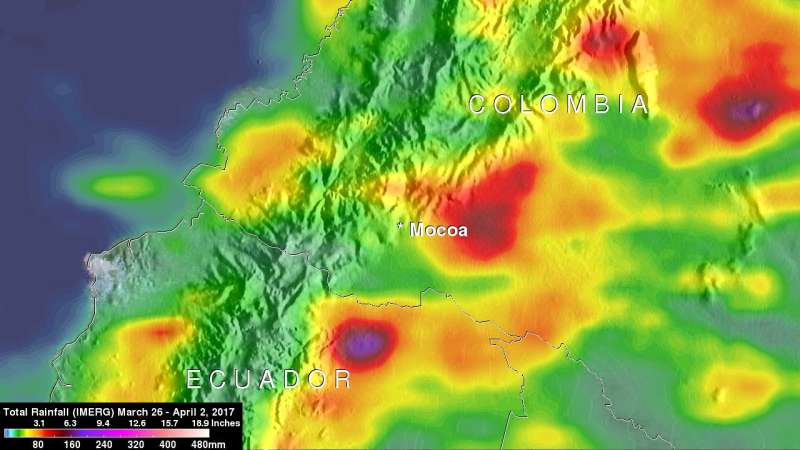NASA analyzes storms that caused deadly Colombia mudslides

NASA conducted an analysis of the heavy rainfall that occurred over Colombia that triggered flooding and mudslides.
Late Friday night, March 31, and early morning Saturday, April 1, flash flooding and mudslides killed more than 250 people in Mocoa, Colombia. Extremely intense storms added heavy rain to waterlogged terrain around Mocoa. Water from this heavy rainfall converged into a river that runs close to Mocoa causing it to overflow its banks with deadly results.
NASA's GPM, or Global Precipitation Measurement, mission satellite provides information on precipitation from its orbit in space. GPM is a joint mission between NASA and the Japan Aerospace Exploration Agency.
GPM also utilizes a constellation of other satellites to provide a global analysis if precipitation. At NASA's Goddard Space Flight Center in Greenbelt, Maryland, those data are incorporated into NASA's IMERG, or Integrated Multi-satellite Retrievals for GPM, to provide a total picture of precipitation events.
IMERG data were used to estimate the amount of rain that fell near Mocoa, Colombia, during a seven-day period from March 26 to April 2, 2017. IMERG indicated that area rainfall totals during the week were frequently greater than 80 mm (3.1 inches). The analysis also showed the locations of heavy rainfall that extended from east of Mocoa into the high mountains that surround the city. Torrents of water rushed from the high terrain and were funneled into the valley where Mocoa is located, causing the flooding and mudslides.
IMERG creates a merged precipitation product from the GPM constellation of satellites. These satellites include DMSPs from the U.S. Department of Defense, GCOM-W from the Japan Aerospace Exploration Agency, Megha-Tropiques from the Centre National D'etudies Spatiales and Indian Space Research Organization, NOAA series from the National Oceanic and Atmospheric Administration, Suomi-NPP from NOAA-NASA, and MetOps from the European Organisation for the Exploitation of Meteorological Satellites. All of the instruments (radiometers) aboard the constellation partners are inter-calibrated with information from the GPM Core Observatory's GPM Microwave Imager (GMI) and Dual-frequency Precipitation Radar (DPR).
Provided by NASA's Goddard Space Flight Center




















